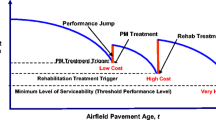Abstract
Optimal application of pavement preservation or preventive maintenance is critical for highway agencies to allocate the limited budget for different treatments. This study developed an integrated life-cycle cost analysis (LCCA) model to quantify the impact of pavement preservation on agency cost and vehicle operation cost (VOC) and analyzed the optimal timing of preservation treatments. The international roughness index (IRI) data were extracted from the long-term pavement performance (LTPP) program specific pavement studies 3 (SPS-3) to determine the long-term effectiveness of preservation treatments on IRI deterioration. The traffic loading and the initial IRI value significantly affects life extension and the benefit of agency cost caused by pavement preservation. The benefit in VOC is one to two orders greater in magnitude as compared to the benefit in agency cost. The optimal timing calculated based on VOC is always earlier than the optimal timing calculated based on agency cost. There are considerable differences among the optimal timing of three preservation treatments.
Similar content being viewed by others
References
Labi S, Sinha K C. Measures of short-term effectiveness of highway pavement maintenance. Journal of Transportation Engineering, 2003, 129(6): 673–683
Morian A D. Cost Benefit Analysis of Including Microsurfacing in Pavement Treatment Strategies & Cycle Maintenance. FHWA-PA- 2011–001–080503, 2011
Wang H, Wang Z. Evaluation of pavement surface friction subject to various pavement preservation treatments. Construction and Building Materials, 2013, 48: 194–202
Peshkin D G, Hoerner T E, Zimmerman K A. Optimal Timing of Pavement Preventive Maintenance Treatment Measures. NCHRP Report 523, Transportation Research Board, 2004
Wei C, Tighe S. Development of preventive maintenance decision trees based on cost-effectiveness analysis an Ontario case study. Transportation Research Record, 2004, 1866: 9–19
Haider SW, Dwaika MB. Estimating optimal timing for preventive maintenance treatments to mitigate pavement roughness. Transportation Record, the 89th Annual Meeting, 2010
Wang G, Morian D, Frith D. Cost-benefit analysis of thin surface treatments in pavement treatment strategies and cycle maintenance. Journal of Materials in Civil Engineering, 2013, 25(8): 1050–1058
Dong Q, Huang B. Evaluation of effectiveness and cost-effectiveness of asphalt pavement rehabilitations utilizing LTPP data. Journal of Transportation Engineering, 2012, 138(6): 681–689
Wang Y, Wang G, Mastin N. Costs and effectiveness of flexible pavement treatments: experience and evidence. Journal of Performance of Constructed Facilities, 2012, 26(4): 516–525
Lu P, Tolliver D. Pavement treatment short-term effectiveness in IRI change using long-term pavement program data. Journal of Transportation Engineering, 2012, 138(11): 1297–1302
Hall K T, Correa C E, Simpson A L. LTPP data analysis: effectiveness of maintenance and rehabilitation options. National Cooperative Highway Research Program, NCHRP Web Document 47 (Project 20-50[3/4]): Contractor’s Final Report, 2002
Labi S, Mahmodi M I, Fang C, Nunoo C. Cost-effectiveness of microsurfacing and thin hot-mix asphalt overlays: comparative analysis. Transportation Research Board 86th Annual Meeting, 2007
Labi S, Lamptey G, Kong S H. Effectiveness of microsurfacing treatments. Journal of Transportation Engineering, 2007, 133(5): 298–307
Haider S W, Baladi G Y. Effect of pavement condition data collection frequency on performance prediction. Transportation Record, 89th Annual Meeting, 2010
Huang B, Dong Q. Optimizing pavement preventive maintenance treatment applications in tennessee (Phase 1). Final Report. Project#: RES1307, 2009
Ong G P, Nantung T, Sinha K C. Indiana Pavement Preservation Program. FHWA/IN/JTRP-2010/14, West Lafayette, IN, 2010
Markow, M J. Life-cycle costs evaluations of effects of pavement maintenance. Transportation Research Record, 1991, 1276: 37–47
ARA Inc. ERES Division. Development of the 2002 Guide for the Design of New and Rehabilitated Pavements. NCHRP 1-37A Report, Transportation Research Board, Washington, D C, 2004
Morosiuk G, Riley M, Toole T. HDM-4 Highway Development & Management. Volume Two, Application Guide. PIARC, World Road Association, 2002, 2–133.
Chatti K, Zaabar I. Estimating the Effects of Pavement Condition on Vehicle Operating Costs. NCHRP 720, Transportation Research Board, Washington, D C, 2012
Author information
Authors and Affiliations
Corresponding author
Rights and permissions
About this article
Cite this article
Wang, Z., Wang, H. Life-cycle cost analysis of optimal timing of pavement preservation. Front. Struct. Civ. Eng. 11, 17–26 (2017). https://doi.org/10.1007/s11709-016-0369-3
Received:
Accepted:
Published:
Issue Date:
DOI: https://doi.org/10.1007/s11709-016-0369-3




